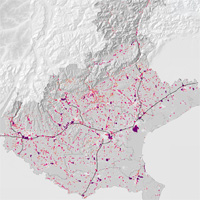Production facilities sprawl: the Veneto's case
Abstract
The issue of urban sprawl is particularly evident in the Italian North-East and particularly in the Veneto.
Within the general settlement sprawl, the spreading and fragmentation of the production system is the result of a distinctive mode of transformations induced by the economical processes. The production facilities sprawl is a process characterized by considerable temporal continuity that has maintained almost intact its antecedents and constituent functional processes with (seemingly simple), continuously adapt to the changing practices of the genius loci.
The understanding of this phenomenon is a key element in planning policies. In fact, next to the well-known problems related to sprawl and common to most of the settlements, the case of diffusion of manufacturing activities has resulted settlement in severe conditions of unsustainability in relations to with specific issues such as the supply of raw materials, the accessibility in general, the provision of infrastructure services, the organization of production activities, the consumption of soil, etc..
The Veneto Region has tried to solve the problems arising from this situation through specific legislative instruments and directing regional planning towards these issues. Indeed, the production facilities sprawl has already been dealt with regional laws 80/1980 and 24/1985 that face the problem from the point of view of diffusion in historical town centers and agricultural areas, even before the approval of the Regional Planning Law (Regional law 61/1985). From a planning perspective, Veneto Region with the Law 11/1987 wrote off all the production facilities outside production settlements, however endorsing the diffusion and fragmentation of the production areas. The problem of non-proliferation of sprawl have therefore remained as a key issue in regional coordination plans.
These paper wants to further illustrate the proposed methodological approach and the principal results of the working group of the Department of Architecture, Planning and Surveying - University of Padua, in the processing steps of the new Regional Territorial Coordination Plan of the Veneto Region.
These reflections, which allowed us to evaluate intervention strategies focused on the recognition of the territory of settlement types specific to refer to.)
Downloads
References
Longhi D., a cura di, (2009), Appunti e riflessioni dei “Proto” sui luoghi e i paesaggi del Veneto. I fondamenti per il buon governo del territorio. PTRC, Regione del Veneto, Venezia
Giunta Regionale del Veneto, a cura di, (2008), Il Veneto si racconta, Regione del Veneto, Venezia
Migliorini F., (2007), Un corridoio tutto da inventare. L’alta velocità per far crescere città e distretti, Marsilio editori, Venezia
Giunta Regionale del Veneto, a cura di, (2006), Quadro strategico regionale, Regione del Veneto, Venezia
Giunta Regionale del Veneto, a cura di, (2006), Il Veneto in cifre, Regione del Veneto, Venezia
Giunta Regionale del Veneto, a cura di, (2005), Questioni e lineamenti di progetto, Regione del Veneto, Venezia
Giunta Regionale del Veneto, a cura di, (2005), Spostamenti sistematici casa - lavoro e casa – studio nella regione Veneto 1991 - 2001, Regione del Veneto, Venezia
Trigilia C., (2005), Sviluppo locale. Un progetto per l’Italia, Laterza, Bari
Giunta Regionale del Veneto, a cura di, (2004), Documento programmatico preliminare per le consultazioni, Regione del Veneto, Venezia
Giunta Regionale del Veneto, a cura di, (2004), Fondamenti del buon governo del territorio. Carta di Asiago, Regione del Veneto, Venezia
Turri E., (2004), La megalopoli padana, Marsilio, Venezia
Giunta Regionale del Veneto, a cura di, (2001), Programma regionale di sviluppo, Regione del Veneto, Venezia
Roverato G., Fontana G.L., (2001), Processi di settorializzazione e distrettualizzazione nei sistemi economici locali. Il caso veneto, in Amatori F., Colli A., a cura di, Comunità di imprese. Sistemi locali in Italia tra Ottocento e Novecento, il Mulino, Bologna
Savi P., (1996), Il Veneto: milieu locali e dinamiche di rete, Franco Angeli editore, Milano
Giunta Regionale del Veneto, a cura di, (1991), Piano Territoriale Regionale di Coordinamento, Regione del Veneto, Venezia

Copyright (c) 2014 Tema. Journal of Land Use, Mobility and Environment

This work is licensed under a Creative Commons Attribution 4.0 International License.
Authors who publish in this journal agree to the following:
1. Authors retain the rights to their work and give in to the journal the right of first publication of the work simultaneously licensed under a Creative Commons License - Attribution that allows others to share the work indicating the authorship and the initial publication in this journal.
2. Authors can adhere to other agreements of non-exclusive license for the distribution of the published version of the work (ex. To deposit it in an institutional repository or to publish it in a monography), provided to indicate that the document was first published in this journal.
3. Authors can distribute their work online (ex. In institutional repositories or in their website) prior to and during the submission process, as it can lead to productive exchanges and it can increase the quotations of the published work (See The Effect of Open Access)
